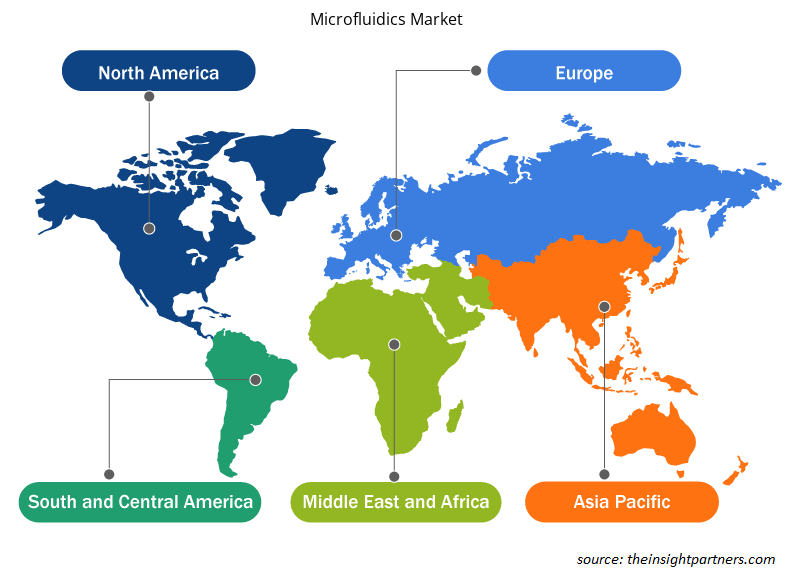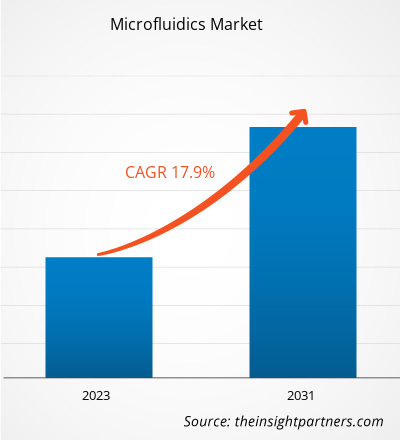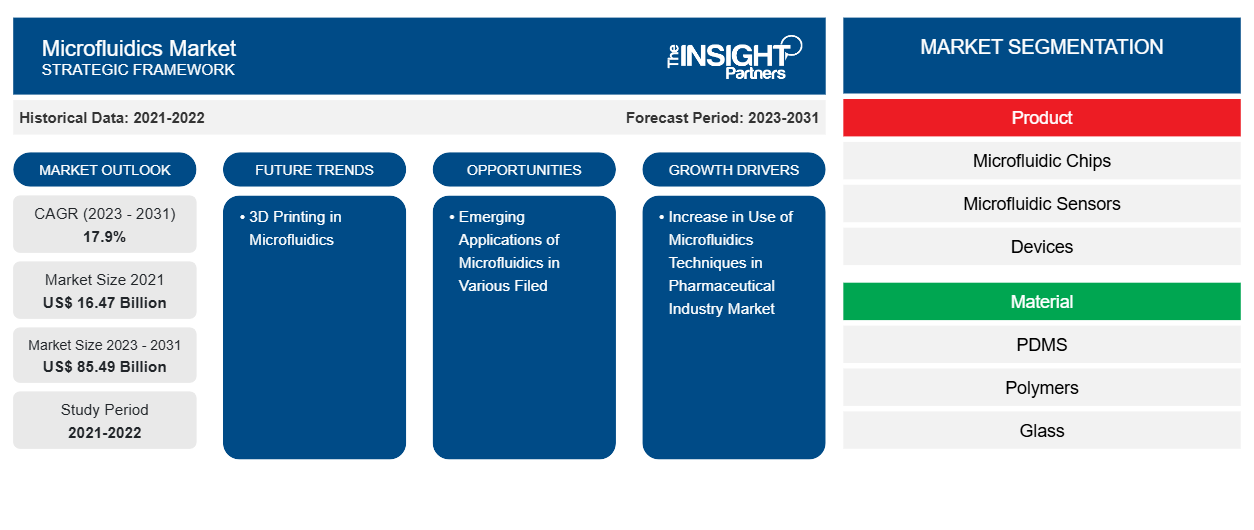بلغت قيمة سوق الميكروفلويديك 16.47 مليار دولار أمريكي في عام 2021 ومن المتوقع أن تصل إلى 85.49 مليار دولار أمريكي بحلول عام 2031. ومن المتوقع أن يسجل السوق معدل نمو سنوي مركب بنسبة 17.9٪ في الفترة 2023-2031. ومن المرجح أن تظل الطباعة ثلاثية الأبعاد في الميكروفلويديك اتجاهًا رئيسيًا في السوق.
تحليل سوق الموائع الدقيقة
يتوسع سوق الميكروفلويديك بسرعة بسبب تطبيقات التكنولوجيا الحيوية والطب والرعاية الصحية. تعد التصغير والأتمتة وقدرات الإنتاجية العالية مكونات مهمة. يشمل اللاعبون في السوق الشركات الراسخة والشركات الناشئة الرائدة في مجالات مثل اختبار نقطة الرعاية وتوصيل الأدوية والتشخيص. تعد أمريكا الشمالية وأوروبا المناطق الرائدة بسبب استثمارها القوي في البنية الأساسية للبحث. يعد التكامل لتحسين الوظائف والكفاءة مع التقنيات الأخرى، مثل الذكاء الاصطناعي وإنترنت الأشياء، أحد الاتجاهات الناشئة في السوق.
نظرة عامة على سوق الموائع الدقيقة
يشتمل علم الموائع الدقيقة على مجالين للدراسة: علم سلوك الموائع في القنوات الدقيقة وتكنولوجيا إنتاج أجهزة دقيقة للغاية ذات أنفاق وغرف لتدفق الموائع أو حبسها. يتعامل مجال الموائع الدقيقة مع أحجام السوائل الصغيرة مثل فيمتوليتر (fL)، أو كوادريليون من اللتر. على المقياس الميكرومتري، تتصرف السوائل بشكل مختلف تمامًا عن نظيراتها في العالم الحقيقي. هذه الخصائص ضرورية للاكتشافات والتجارب العلمية الجديدة. في هذه الأيام، يقدم علم الموائع الدقيقة أدوات فعالة لمختلف مجالات الدراسة، وخاصة التحليل البيولوجي. مع تبسيط العملية البيولوجية الكاملة وتكاملها للمستخدمين النهائيين، والاختبارات ذات الإنتاجية العالية، والإرسال المتعدد، والتحليلات السريعة المتوازية العالية بسبب الأوقات المختصرة للتفاعلات والفصل، والأدوات المحمولة للاستخدام في إعدادات الرعاية الصحية، واستخدام الكواشف إلى الحد الأدنى، والحد من التكاليف العالمية لكل تحليل، تمكن علم الموائع الدقيقة من القياس الدقيق. كما أنه يرفع دقة القياس في تطبيقات محددة، وما إلى ذلك، وهي الفوائد التي يقدمها علم الموائع الدقيقة. وقد يؤدي هذا إلى ارتفاع الطلب على الموائع الدقيقة، مما يعزز نمو السوق.
قم بتخصيص هذا التقرير ليناسب متطلباتك
ستحصل على تخصيص لأي تقرير - مجانًا - بما في ذلك أجزاء من هذا التقرير، أو تحليل على مستوى الدولة، وحزمة بيانات Excel، بالإضافة إلى الاستفادة من العروض والخصومات الرائعة للشركات الناشئة والجامعات
-
احصل على أهم اتجاهات السوق الرئيسية لهذا التقرير.ستتضمن هذه العينة المجانية تحليلاً للبيانات، بدءًا من اتجاهات السوق وحتى التقديرات والتوقعات.
محركات وفرص سوق الموائع الدقيقة
زيادة استخدام تقنيات الموائع الدقيقة في سوق صناعة الأدوية
لقد أدرجت صناعة الأدوية العديد من العمليات الدقيقة في الطب الشخصي لإيجاد وتقديم أدوية جديدة. يمكن لأجهزة الميكروفلويديك تسريع العديد من مراحل العملية، مثل اختيار الهدف، والتجارب السريرية، والتوليف الكيميائي، ودراسات التركيبات، وإدارة المنتج. ونظراً للتكاليف العالية للبحث والتطوير في مجال الأدوية، فإن هذه التطورات قد تساعد المستهلكين في نهاية المطاف وتدفع نمو السوق.microfluidic processes in personalized medicine to find and deliver novel medications. Microfluidic devices can accelerate numerous stages of the process, such as target selection, clinical trials, chemical synthesis, formulations studies, and product management. Given the high expense of drug R&D, these developments might eventually help consumers and drive market growth.
التطبيقات الناشئة للميكروفلويديك في مختلف المجالات – فرصة في سوق الميكروفلويديك
في مجال البحث الأكاديمي، لا تزال تقنية الميكروفلويديك تشكل مجالاً متعدد التخصصات حيث يتعاون المهندسون وعلماء الأحياء الخلوية. والهدف من هذه الشراكات هو تحسين تجارب زراعة الخلايا بشكل مستمر. وعلى العكس من ذلك، بدأ القطاع الطبي الحيوي الآن فقط في الاستفادة من تقنية الميكروفلويديك إلى حد كبير. وقد تم استخدام أجهزة الميكروفلويديك في العديد من التطورات الحديثة المهمة في دراسة وإنشاء عقاقير علاجية جديدة وتشخيصات طبية. على سبيل المثال، بالنسبة لفحص الدم البسيط، يتطلب استخدام جهاز ميكروفلويديك كمية أقل من الدم ويسرع بشكل كبير من أوقات المعالجة. كما تستخدم فرق البحث والتطوير تقنيات الميكروفلويديك لاختبار الأدوية الجديدة. وبالتالي، فإن الزيادة في تطبيق تقنيات الميكروفلويديك من المرجح أن تخلق فرصًا وفيرة في السوق.
تحليل تجزئة تقرير سوق الموائع الدقيقة
إن القطاعات الرئيسية التي تساهم في اشتقاق تحليل سوق الموائع الدقيقة هي المنتج والتكنولوجيا والمواد والتطبيق.
- بناءً على نوع العلاج، يتم تقسيم سوق المنتجات إلى رقائق ميكروفلويدية، وأجهزة استشعار ميكروفلويدية، وأجهزة، ومضخات دقيقة، وإبر دقيقة، ومنتجات أخرى. احتل قطاع الأجهزة حصة سوقية أكبر في عام 2023.
- بحسب المواد، يتم تقسيم السوق إلى PDMS والبوليمرات والزجاج والسيليكون ومواد أخرى. احتل قطاع PDMS الحصة الأكبر من السوق في عام 2023.
- من حيث التطبيق، يتم تقسيم السوق إلى التشخيص المختبري، والبحث في مجال الأدوية وعلوم الحياة، واكتشاف الأدوية، وتطبيقات أخرى. وقد استحوذ قطاع التشخيص المختبري على أكبر حصة من السوق في عام 2023.
تحليل حصة سوق الموائع الدقيقة حسب المنطقة الجغرافية
ينقسم النطاق الجغرافي لتقرير سوق الموائع الدقيقة إلى خمس مناطق: أمريكا الشمالية، وآسيا والمحيط الهادئ، وأوروبا، والشرق الأوسط وأفريقيا، وأمريكا الجنوبية/أمريكا الجنوبية والوسطى.
سيطرت أمريكا الشمالية على سوق الموائع الدقيقة. في أمريكا الشمالية، تعد الولايات المتحدة أكبر سوق للموائع الدقيقة في عام 2023. السوق في المنطقة مدفوع مبدئيًا بزيادة أنشطة البحث والتطوير، والتبني المبكر للتقدم التكنولوجي، والاستثمار الكبير من قبل اللاعبين الرئيسيين. على سبيل المثال، في مايو 2021، أعلنت شركة Nuclear، وهي شركة تكنولوجيا حيوية سريعة التوسع تعمل على إنشاء تقنيات تخليق البروتين والجينات الإنزيمية، وE Ink، رائدة الصناعة في تكنولوجيا الحبر الإلكتروني، أن وحدة الموائع الدقيقة الرقمية لشركة E Ink قد استحوذت عليها شركة Nuclera، وهي شركة تابعة أمريكية تم إنشاؤها حديثًا.
رؤى إقليمية حول سوق الموائع الدقيقة
لقد قام المحللون في Insight Partners بشرح الاتجاهات والعوامل الإقليمية المؤثرة على سوق الموائع الدقيقة طوال فترة التوقعات بشكل شامل. يناقش هذا القسم أيضًا قطاعات سوق الموائع الدقيقة والجغرافيا في جميع أنحاء أمريكا الشمالية وأوروبا ومنطقة آسيا والمحيط الهادئ والشرق الأوسط وأفريقيا وأمريكا الجنوبية والوسطى.

- احصل على البيانات الإقليمية المحددة لسوق الموائع الدقيقة
نطاق تقرير سوق الموائع الدقيقة
| سمة التقرير | تفاصيل |
|---|---|
| حجم السوق في عام 2021 | 16.47 مليار دولار أمريكي |
| حجم السوق بحلول عام 2031 | 85.49 مليار دولار أمريكي |
| معدل النمو السنوي المركب العالمي (2023 - 2031) | 17.9% |
| البيانات التاريخية | 2021-2022 |
| فترة التنبؤ | 2023-2031 |
| القطاعات المغطاة |
حسب المنتج
|
| المناطق والدول المغطاة |
أمريكا الشمالية
|
| قادة السوق وملفات تعريف الشركات الرئيسية |
|
كثافة اللاعبين في سوق الموائع الدقيقة: فهم تأثيرها على ديناميكيات الأعمال
يشهد سوق الموائع الدقيقة نموًا سريعًا، مدفوعًا بالطلب المتزايد من المستخدم النهائي بسبب عوامل مثل تفضيلات المستهلكين المتطورة والتقدم التكنولوجي والوعي المتزايد بفوائد المنتج. ومع ارتفاع الطلب، تعمل الشركات على توسيع عروضها والابتكار لتلبية احتياجات المستهلكين والاستفادة من الاتجاهات الناشئة، مما يؤدي إلى زيادة نمو السوق.
تشير كثافة اللاعبين في السوق إلى توزيع الشركات أو المؤسسات العاملة في سوق أو صناعة معينة. وهي تشير إلى عدد المنافسين (اللاعبين في السوق) الموجودين في مساحة سوق معينة نسبة إلى حجمها أو قيمتها السوقية الإجمالية.
الشركات الرئيسية العاملة في سوق الموائع الدقيقة هي:
- شركة اجيلنت للتكنولوجيا
- بنغلاديش
- مختبرات بيو راد
- داناهر
- الموائع الدقيقة للدولوميت (شركة بلاك تريس القابضة المحدودة)
- شركة فلوديجم
إخلاء المسؤولية : الشركات المذكورة أعلاه ليست مرتبة بأي ترتيب معين.

- احصل على نظرة عامة على أهم اللاعبين الرئيسيين في سوق الموائع الدقيقة
أخبار سوق الموائع الدقيقة والتطورات الأخيرة
يتم تقييم سوق الموائع الدقيقة من خلال جمع البيانات النوعية والكمية بعد البحث الأولي والثانوي، والتي تتضمن منشورات الشركات المهمة وبيانات الجمعيات وقواعد البيانات. فيما يلي قائمة بالتطورات في سوق الموائع الدقيقة والاستراتيجيات:
- أعلنت شركة CellFE Inc.، وهي شركة مبتكرة في مجال الموائع الدقيقة مخصصة لتحويل تطوير وتصنيع العلاجات الخلوية المتقدمة، عن التوافر التجاري لمنصتها الهندسية الخلوية Infinity Mtx، والتي تستخدم ضغط الخلايا السريع وإعادة التوسع لنقل الحمولة المستهدفة بنشاط إلى الخلية. تشمل فوائد منصة الهندسة الخلوية الدقيقة من CellFE إنتاجية عالية من الخلايا المحررة، وأوقات استرداد الخلايا وتوسعها المنخفضة، والاستيعاب الفعال للحمولات المتنوعة، مما يعني أوقاتًا أقصر من الوريد إلى الوريد وتكاليف تصنيع أقل. (المصدر: اسم شركة CellFE Inc، بيان صحفي، 2023)
- استحوذت شركة TE Connectivity، وهي شركة رائدة عالميًا في مجال الموصلات وأجهزة الاستشعار، على ثلاث شركات تركز على تطوير عبوات الخراطيش الدقيقة والكواشف البثورية، واختبارات قابلية الاستخدام، والبحوث السريرية والتصنيع. (المصدر: اسم شركة TE Connectivity، النشرة الإخبارية، 2021)
تغطية تقرير سوق الموائع الدقيقة والمنتجات النهائية
يوفر تقرير "حجم سوق الموائع الدقيقة والتوقعات (2021-2031)" تحليلاً مفصلاً للسوق يغطي المجالات التالية:
- حجم السوق والتوقعات على المستويات العالمية والإقليمية والوطنية لجميع قطاعات السوق الرئيسية التي يغطيها النطاق
- ديناميكيات السوق مثل المحركات والقيود والفرص الرئيسية
- الاتجاهات المستقبلية الرئيسية
- تحليل مفصل لقوى PEST/Porter الخمس وSWOT
- تحليل السوق العالمي والإقليمي الذي يغطي اتجاهات السوق الرئيسية واللاعبين الرئيسيين واللوائح والتطورات الأخيرة في السوق
- تحليل المشهد الصناعي والمنافسة الذي يغطي تركيز السوق، وتحليل خريطة الحرارة، واللاعبين البارزين، والتطورات الأخيرة
- ملفات تعريف الشركة التفصيلية
- التحليل التاريخي (سنتان)، سنة الأساس، التوقعات (7 سنوات) مع معدل النمو السنوي المركب
- تحليل PEST و SWOT
- حجم السوق والقيمة / الحجم - عالمي، إقليمي، بلد
- الصناعة والمنافسة
- مجموعة بيانات إكسل
التقارير الحديثة
شهادات العملاء
سبب الشراء
- اتخاذ قرارات مدروسة
- فهم ديناميكيات السوق
- تحليل المنافسة
- رؤى العملاء
- توقعات السوق
- تخفيف المخاطر
- التخطيط الاستراتيجي
- مبررات الاستثمار
- تحديد الأسواق الناشئة
- تحسين استراتيجيات التسويق
- تعزيز الكفاءة التشغيلية
- مواكبة التوجهات التنظيمية























 احصل على عينة مجانية ل - سوق الموائع الدقيقة
احصل على عينة مجانية ل - سوق الموائع الدقيقة